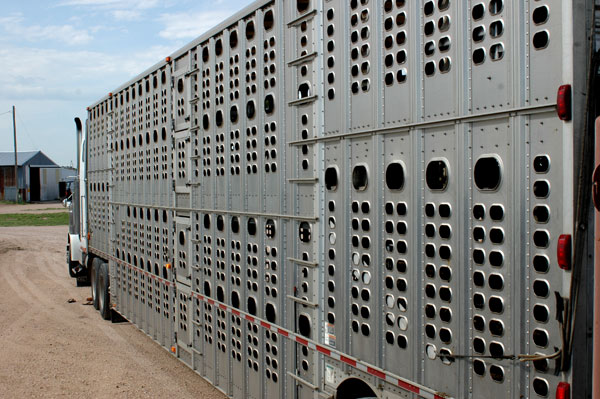Tyson fire disrupts markets, supply chain
While the market impact of the Tyson beef plant fire is yet to be felt, it will likely be substantial.
August 13, 2019

The fire that partly destroyed the Tyson Foods Finney County beef plant in Holcomb, Kan., (near Garden City) on Friday, August 10, took cattle futures limit down Monday morning as traders tried to assess what lost fed cattle slaughter capacity means to markets.
“The plant operated at about 6,000 head of fed cattle per day, leaving a shortfall in the national packing capacity of 30,000 head for a five-day work week,” say representative of the Kansas Livestock Association (KLA), in a Monday assessment for its members. “According to CattleFax, that amounts to 6% of total U.S. fed cattle packing capacity the rest of the processing industry will need to absorb. The plant represents 23.5% of Kansas fed cattle packing capacity.”
Fed cattle slaughter average 522,769 head per week from the week ending May 4 to the week ending July 27, according to USDA’s Actual Slaughter Under Federal Inspection reports.
“The loss of 30,000-35,000 head of slaughter capacity per week will disrupt both boxed beef and fed cattle markets at least initially and potentially longer, depending on the duration of the plant closure,” says Derrell Peel, Extension livestock marketing specialist at Oklahoma State University, in his weekly market comments.
“The disruptions will add costs for both fed cattle and boxed beef as additional logistics are needed to adjust flows of slaughter cattle and boxed beef. There are many unknowns for Tyson and the industry going forward, including the possibility that this sets the stage for new investment in beef packing. The U.S. has not seen major new beef packing infrastructure for many years.”
By all measures, beef packing capacity utilization is running historically high as consumer beef demand and packer economics encourage timely harvest of record large fed cattle supplies.
According to KLA, “Based on CattleFax analysis, shifting the supply to other plants in Kansas, Texas, Colorado, Nebraska and Iowa will mean capacity in those regions needs to run 8% to 8.5% higher. The market analysis service reports this will be difficult to make up based on current packing industry infrastructure.
“CattleFax suggests the significance of this event is amplified by the growing supply of finished cattle both nationwide and in Kansas. The U.S. cattle on feed total in feedyards with 1,000 or more head capacity was record large at 11.5 million head July 1. Cattle on feed in Kansas as of July 1 stood at 2.4 million head, which was also a record and represented about 21% of U.S. total.”
Tyson plans to rebuild the Holcomb plant at the same location. Officials are still assessing the damage, so it’s too early to establish a timeline, but work to clear damage has begun.
In the meantime, Steve Stouffer, group president of Tyson Fresh Meats explains, “We’re taking steps to move production to alternative sites. Tyson Foods has built in some redundancy to handle situations like these and we will use other plants within our network to help keep our supply chain full.”
“Potential market impacts predicted by CattleFax include a possible loss of currentness in the cattle feeding segment, cattle feeders could lose some market leverage and all classes of cattle could see more price risk,” according to KLA. “Some of the pressure could be alleviated if existing harvest capacity dedicated to cows and bulls is incentivized to process fed cattle and if plants have the cooler, boxed beef capacity and labor to process cattle on weekends.”
The impact of this event on fed cattle markets will be substantial, says Stephen Koontz, ag economics professor at Colorado State University. Writing for the Livestock Marketing Information Center’s “In the Cattle Markets” newsletter, he says the market is in the middle of the third quarter: supplies are heaviest, slaughter weights are ramping up and competing meat supplies will begin their fall increase.
“This is the quarter with the highest volume of beef supplies and forecasts are for sustained supplies into the fourth quarter. Disruption in the Southern Plains will spill over nationally. I anticipate that there will be more than a modest degree of panic as the largest annual supplies are moved around temporally and spatially,” he says.
“The rest of this month [August 2019] will be difficult and there is the potential for the disruption and accompanying volatility to continue into much of the fall. The inventory of cattle is rather clear but the impact of this disruption on planning and orderly marketing is not.”
Tyson Foods operates six plants in Kansas, employing more than 5,600 people. In the company’s fiscal year 2018, it paid $269 million in wages within Kansas and estimated its total economic impact in the state to be more than $2.4 billion.
“This is a difficult time for our team members and their families, and we want to ensure they’re taken care of,” Stouffer said Monday. “Today, we will notify our full-time, active team members that they’ll be paid weekly until production resumes.”
About the Author(s)
You May Also Like




.png?width=300&auto=webp&quality=80&disable=upscale)
